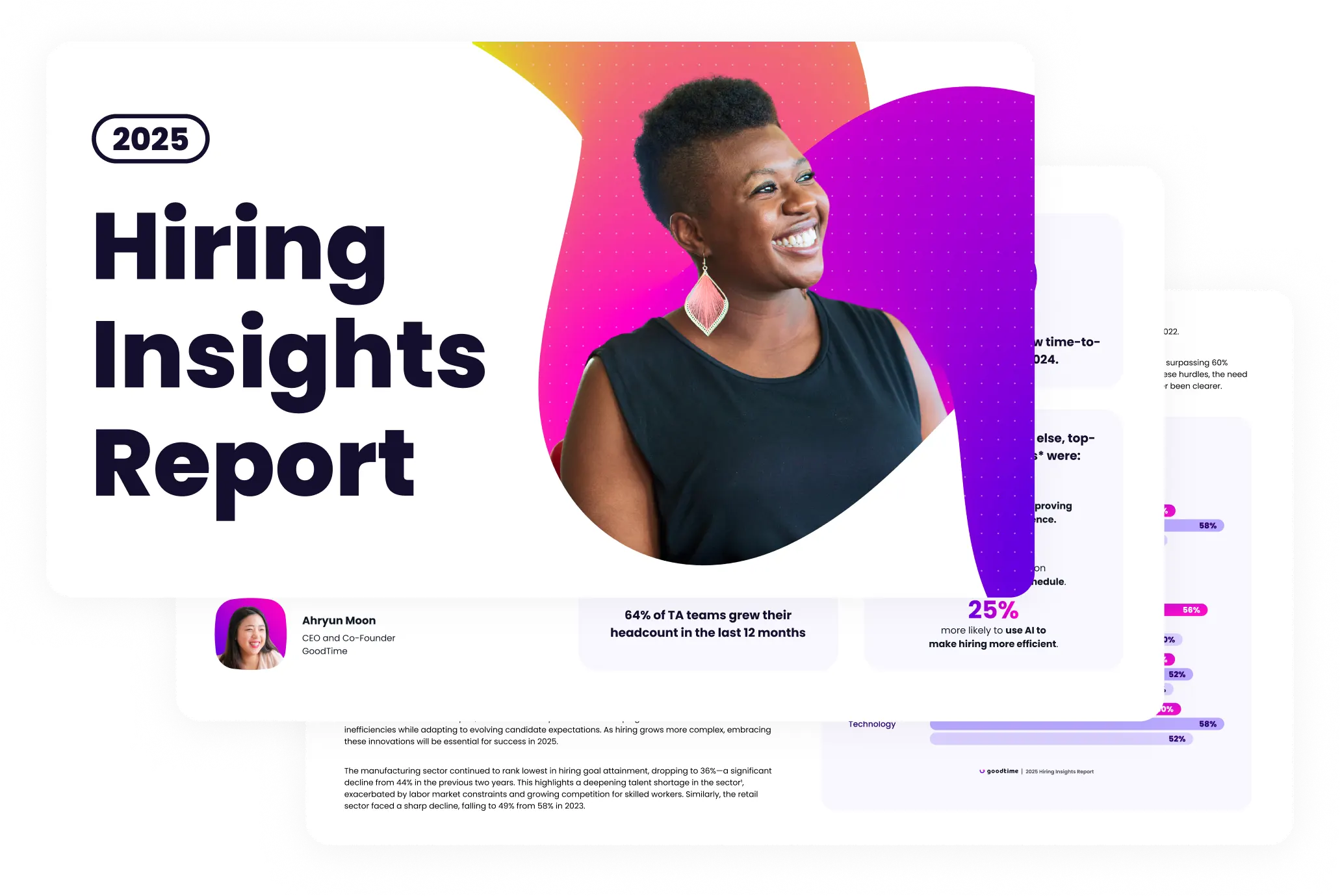Tracking and analyzing employment metrics is essential to understanding how your organization’s workforce is performing. Digging into this data helps you find areas for improvement and optimize your human resource strategies.
One key metric all human resource (HR) leaders should keep an eye on is the employee turnover rate. A high employee turnover rate can significantly hinder business performance, so you need to be able to identify changes in your turnover rate and take action to correct it as soon as possible.
Use this guide to learn how to calculate the employee turnover rate and use the calculation to improve recruitment and retention in your workplace. The expert insights included will give you even more ideas for leveraging your employee turnover rate calculations. The calculation alone is an interesting statistic, but taking that data and turning it into practical applications is much more useful.

Unlock 2025’s top hiring strategies: Insights from 500+ TA leaders
Be the first to uncover deep hiring insights specific to your sector — straight from the highest-performing TA teams.

What is the employee turnover rate?
Employee turnover rate refers to the percentage of employees in your workforce who leave the organization during a given period. General employee turnover includes any time an employee leaves the organization — whether by choice or because the company terminates them.
When the employee chooses to resign or quit, however, that is voluntary turnover. On the other hand, involuntary turnover is when the employer initiates the separation.
The best practice is to track voluntary and involuntary turnover both separately and together. Knowing which of these components makes up the bulk of your overall turnover rate will better inform business decisions.
In October 2024, the average employee turnover rate across all industries was 3.3%, according to the Bureau of Labor Statistics. Note that employee turnover can fluctuate according to broader economic and social conditions as well as internal organizational practices. For reference, the average employee turnover rate across all industries was 5.2% just a year earlier, in October 2023.
mportance of your employee turnover rate
A higher employee turnover rate means your employees leave more frequently, which typically speaks to a problem with either your hiring or retention efforts. Retaining top talent is among the top hiring challenges, cited by 34% of surveyed talent acquisition leaders in GoodTime’s Hiring Insights Report.
It’s also just more difficult to plan for the future if you’re consistently losing employees and having to replace them. You lose continuity and fluidity in your workforce.
That’s why tracking your employee turnover rate alongside recruiting analytics is essential. If there’s a weakness in your retention efforts or talent acquisition strategy, your turnover rate will probably reflect that.
Tracking this metric over time will show how changing your policies affects your ability to hold on to your workers. You’ll also gain insights into which areas you can improve by comparing your voluntary and involuntary turnover rates.
How to calculate the employee turnover rate
You’ll need a few data points on hand to calculate your employee turnover rate. First, decide what time period you want to examine. HR leaders often examine employee turnover on a monthly, quarterly, and annual basis. You can choose any of them or pick a custom period for your calculation. Then, you need to know exactly how many employees left your organization during your selected period.
The last piece of data you need is the average total number of employees your organization had during this period. You can find this average by adding up the total employees you had during your selected period and dividing it by the number of days, months, or years in the period.
For example, your average number of employees over the year is your employees in January plus employees in February, March, and other months of the year, divided by 12.
Calculate your turnover rate with this formula:
Employee turnover rate = (total number of employees who left during the period of interest / average total employees in your workforce during the period of interest)
Looking at some sample calculations will help make this easier to understand.
Annual employee turnover calculation
The HR team at Organization A wants to calculate their employee turnover for the year. Over the past 12 months, Organization A averaged a workforce of around 1,000 employees. A total of 63 employees left the organization this year — 28 were voluntary turnover, and 35 were involuntary turnover.
Employee turnover rate = 63/1,000
You get 0.063 or 6.3%. Organization A had an annual employee turnover rate of 6.3% this year.
You can use the same formula to calculate the voluntary and involuntary turnover components. The voluntary annual employee turnover rate for Organization A this year was 28/1000 or 2.8%, and the involuntary annual employee turnover rate was 35/1000 or 3.5%. Together, they add up to the total annual employee turnover rate of 6.3%.
Quarterly employee turnover calculation
Say Company B is more interested in its quarterly employee turnover. Over the last quarter, Company B averaged 20 employees. Three employees left the organization over this period — all three were fired. There was no voluntary turnover during the quarter.
Employee turnover rate = 3/20
The quarterly employee turnover rate is 15%.
It’s normal for small and midsized businesses (SMBs) to have higher employee turnover rates than enterprises and the average across all business sizes. However, a turnover rate of 15% is likely still concerning.
Company B should take this data and look into their resume screening and interview process to see what’s going wrong, especially since this was all involuntary turnover. The HR leaders could likely improve their hiring process to bring on reliable, qualified employees whom the company won’t need to fire anytime soon.
Monthly employee turnover calculation
Enterprise C wants to know its employee turnover for this month. The enterprise averaged 15,000 total employees this month, and 300 employees left during this period. One hundred seventy-seven resigned or quit, and Enterprise C fired the other 123 employees.
Employee turnover rate = 300/15,000
This results in an employee turnover rate of 0.02 or 2%. Clearly, the enterprise’s hiring and retention efforts are going well to have such a low employee turnover rate.
Challenges in calculating turnover rate and solutions
Though the formula is fairly simple, employee turnover rate can sometimes be challenging to calculate. Some organizations may not have access to complete data on who left and when.
You may also encounter issues categorizing turnover. For example, if an employee leaves on a six-month sabbatical and requires a temporary replacement, should you count that employee toward your turnover rate?
You have to decide for yourself exactly how you define employee turnover in your organization and use data that corresponds with that definition in your calculations. Asking all employees who are leaving to complete exit surveys is one way to get more data about turnover. You can include a point about why the employee is leaving and then use that data to understand the driving forces behind your employee turnover rate.
Using HR tools to track employee data will also help you more reliably calculate employee turnover and other employment metrics. For example, GoodTime’s recruiting analytics features automatically track metrics like time-to-schedule and turnaround time so you can analyze your hiring process and find areas for improvement. When you pair GoodTime with other HR software that tracks employees’ lifecycle with your organization and exit survey data, you’ll have all the information you need to calculate employee turnover and derive actionable insights.
Leveraging turnover data to improve recruitment and retention
It’s not enough to simply calculate your employee turnover rate and move on. You should track your rate over time and use that information to gather insights about your workforce. Then, use those insights to create more effective, data-driven hiring strategies and retention efforts in your organization.
Craig Pyke, Director of Talent Acquisition at Rivian, highlights the importance of your employee turnover, specifically soon after hiring a new worker. “You can look at attrition within the first 90 days as one indicator of quality of hire,” he shares. If you notice many employees leaving, either voluntarily or involuntarily, within their first three months, you need to take a closer look at your hiring process and make improvements.
He continues, “When you combine exit survey data of why that they’re leaving with the factor of them attriting within 90 days, you can really start to pinpoint if that’s a TA challenge or if that’s a challenge somewhere within the business. That’s super, super important.”
For example, you may see high employee turnover early on in your employees’ relationship with you if you’re consistently hiring under-qualified workers who you then need to fire soon after hiring. Alternatively, your employee turnover data might show that most of the turnover is voluntary, likely meaning your onboarding process or employee management needs improvement.
Use data-driven decision-making to optimize your workforce management
Regularly measuring your employee turnover rate is key to understanding your workforce. If your turnover rate is high or rising, take that as a sign to make changes. Dig deeper into your turnover data and information from your exit surveys to pinpoint what’s causing employees to leave your organization at concerning rates.
Use these insights to make changes and watch your turnover rate improve. You can view the employee turnover rate calculation as a proactive tool for improving workforce stability.




